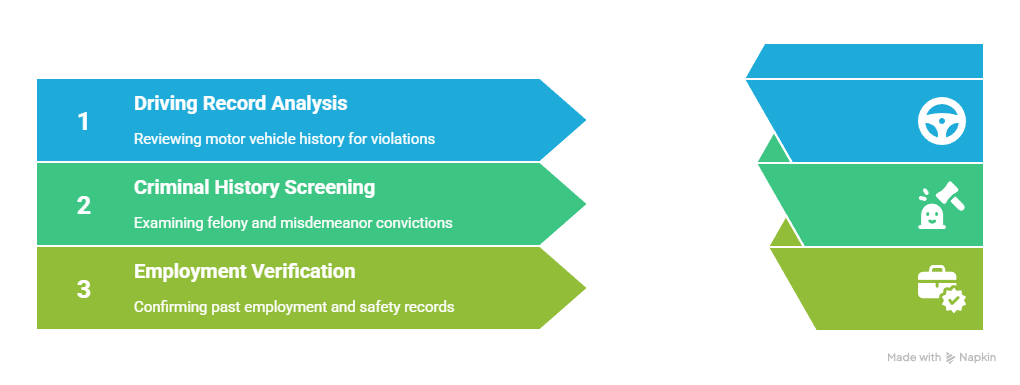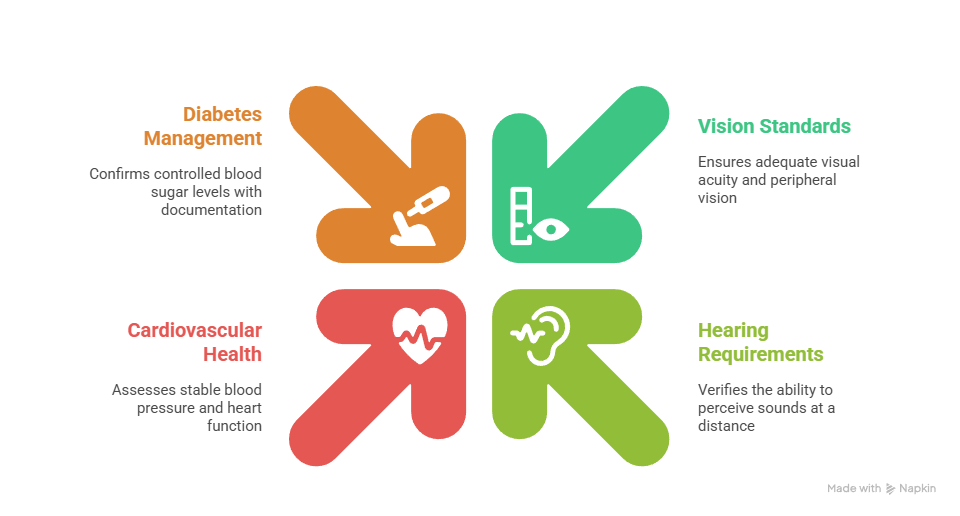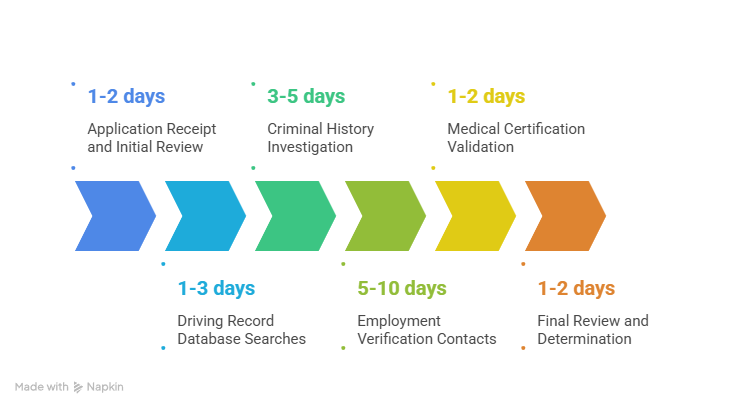Ohio commercial transportation background checks serve as comprehensive screening processes mandated by the Ohio Bureau of Motor Vehicles (BMV) and governed by ORC Chapter 4506, ensuring only qualified drivers operate commercial vehicles on state roads. These multi-component evaluations examine driving records, criminal history, employment verification, and medical certifications to maintain the highest safety standards in Ohio's trucking and logistics industries.
Key Takeaways
- Ohio commercial transportation background checks encompass driving record analysis, criminal history screening, employment verification, and DOT medical certification reviews under BMV oversight and ORC Chapter 4506 regulations.
- Serious traffic violations like DUIs, reckless driving, and out-of-state infractions can permanently or temporarily disqualify commercial driver license applicants from Ohio's transportation industry.
- Criminal history screenings focus on felony convictions and drug-related misdemeanors, with lifetime bans applying to those who commit felonies using commercial vehicles or drug trafficking offenses.
- Employers must comply with Fair Credit Reporting Act (FCRA) requirements, including pre-adverse action notices and ongoing monitoring obligations for hired commercial drivers.
- Background check processing typically takes 3-10 business days, with driving records completing fastest (1-2 days) and employment verification taking longest (up to 2 weeks).
- Job seekers can improve their background check outcomes by addressing record inaccuracies proactively, maintaining current DOT medical certifications, and preparing transparent explanations for any negative information.
Introduction
Navigating Ohio's background check requirements for commercial transportation can determine whether you secure a lucrative driving career or face unexpected roadblocks. Furthermore, understanding these processes becomes crucial as Ohio's trucking industry continues expanding, creating thousands of new opportunities annually. However, strict regulatory compliance means that even minor oversights can derail promising career prospects.
Meanwhile, employers face increasing pressure to conduct thorough screenings while managing costs and timeline expectations. Additionally, recent regulatory updates have streamlined certain processes while tightening others, making current knowledge essential for success. Consequently, both job seekers and employers need comprehensive guidance to navigate these complex requirements effectively.
Understanding Ohio Commercial Transportation Background Checks
Ohio commercial transportation background checks represent systematic evaluations designed to assess the suitability of individuals seeking Commercial Driver's Licenses (CDL) or employment within the state's trucking, delivery, and logistics sectors. Moreover, these comprehensive screenings serve multiple purposes: protecting public safety, ensuring regulatory compliance, and maintaining industry standards across Ohio's commercial transportation network.
The Ohio Bureau of Motor Vehicles (BMV) establishes the foundational framework for these background investigations, while the Ohio Revised Code (ORC) Chapter 4506 provides the legal authority governing their implementation. Additionally, every component of these checks carries significant weight—from in-state driving violations to multi-state criminal records—creating a thorough assessment of each candidate's fitness for commercial vehicle operation.
Core Components of Background Check Evaluations

Driving Record Analysis
Driving record examination forms the cornerstone of Ohio commercial transportation background checks, scrutinizing every aspect of an applicant's motor vehicle history across all states where they've held licenses. Furthermore, moving violations, license suspensions, and DUI convictions receive particular attention, as these infractions directly correlate with road safety risks and operational liability concerns.
Ohio authorities access the National Driver Register and state-specific databases to compile comprehensive driving histories spanning multiple jurisdictions. Typically, a standard driving record check takes 1-2 days to complete. However, more extensive multi-state searches may require 3-5 business days depending on interstate cooperation and data availability.
Critical Disqualifying Violations:
- DUI/OVI Convictions: Result in automatic CDL disqualification periods ranging from one year to lifetime bans
- Reckless Driving: Indicates poor judgment and poses significant safety risks to employers
- Excessive Speeding: Multiple infractions suggest pattern of unsafe driving behaviors
- Hit-and-Run Incidents: Demonstrate lack of responsibility and potential criminal liability
Criminal History Screening
Criminal background investigations examine lifetime felony records and relevant misdemeanor convictions that could impact commercial driving eligibility. Subsequently, Ohio takes an especially strict stance on certain criminal categories, implementing permanent disqualifications for specific offense types while allowing case-by-case evaluation for others.
Felony convictions involving commercial vehicles result in lifetime CDL disqualification under ORC Chapter 4506 regulations. Similarly, drug trafficking offenses, violent crimes, and theft-related felonies receive similar treatment due to their correlation with operational risks and insurance liability exposure.
Permanent Disqualification Offenses:
- Commercial Vehicle Felonies: Any felony committed using a commercial motor vehicle
- Drug Trafficking: Manufacturing, distributing, or dispensing controlled substances
- Violent Crimes: Assault, robbery, or weapons-related felonies
- Commercial License Fraud: Falsifying CDL applications or documentation
Temporary Disqualification Factors:
- First-Time DUI: Typically results in one-year CDL suspension
- Drug Possession: May warrant 60-day to one-year disqualification periods
- Traffic Violations: Serious moving violations can trigger temporary suspensions
Employment Verification Process
Employment history verification ensures candidates possess legitimate commercial driving experience while identifying potential performance or safety concerns from previous positions. Additionally, this process involves contacting former employers, verifying employment dates, and confirming job responsibilities and performance evaluations.
Verification timelines vary significantly based on former employer responsiveness, with most checks completing within 5-10 business days. However, manual verification processes for smaller companies or defunct businesses may extend this timeframe to two weeks or longer.
Verification Components:
- Employment Dates: Confirming actual start and end dates for accuracy
- Job Responsibilities: Validating claimed commercial driving experience
- Performance Records: Reviewing safety incidents, violations, or disciplinary actions
- Reason for Separation: Understanding circumstances surrounding employment termination
Consequently, employment gaps exceeding 30 days require detailed explanations, as unexplained periods may indicate undisclosed problems or instability concerns that warrant further investigation.
Ohio BMV Requirements and CDL Application Process
CDL Application Background Check Requirements
The Ohio BMV mandates comprehensive background screenings for all Commercial Driver's License applications, creating multiple checkpoints throughout the licensing process. Moreover, initial applications trigger automated database searches across criminal justice and motor vehicle record systems, while renewal applications update existing records with recent activity.
Applicants must provide complete residential history for the preceding ten years, enabling thorough jurisdiction-specific background investigations. Subsequently, Social Security number verification confirms identity and work authorization status, while self-disclosure requirements mandate reporting of all criminal charges and traffic violations regardless of disposition.
The CDL application process typically requires 7-14 business days for completion, assuming no complications arise during background verification stages. However, complex cases involving multi-state records or criminal history may extend processing timelines to 3-4 weeks.
Medical Certification and Physical Standards
DOT medical certification represents a critical component of CDL eligibility, requiring candidates to demonstrate physical and mental fitness for commercial vehicle operation. Additionally, as of 2025, the Federal Motor Carrier Safety Administration (FMCSA) electronically transmits examination results directly to the Ohio BMV, streamlining the certification process while maintaining rigorous health standards.
Medical Examination Requirements:

- Vision Standards: 20/40 corrected vision in each eye with 70-degree peripheral vision
- Hearing Requirements: Ability to perceive forced whisper at five feet or hearing aid compatibility
- Cardiovascular Health: Blood pressure below 180/110 with stable cardiovascular function
- Diabetes Management: Controlled blood sugar levels with physician documentation
Furthermore, medical certifications require renewal every 24 months for most drivers. However, certain conditions may necessitate annual examinations or shorter certification periods based on individual health circumstances.
Disqualifying Factors Under ORC Chapter 4506
Permanent Disqualification Scenarios
Ohio Revised Code Chapter 4506 establishes clear guidelines for permanent CDL disqualification, creating zero-tolerance policies for specific offense categories that pose unacceptable risks to public safety. Moreover, these lifetime bans reflect the serious responsibility associated with commercial vehicle operation and the potential consequences of driver misconduct.
| Offense Category | Disqualification Period | Additional Consequences |
| Commercial Vehicle Felony | Lifetime | Criminal prosecution, civil liability |
| Drug Trafficking | Lifetime | Federal charges possible |
| Multiple DUI Convictions | Lifetime | Personal license revocation |
Temporary Disqualification Periods
Temporary disqualifications provide opportunities for rehabilitation while maintaining safety standards through supervised re-entry processes. Additionally, these graduated sanctions recognize that some violations may represent isolated incidents rather than patterns of unsafe behavior.
Standard Disqualification Periods:
- First DUI Offense: 12 months (6 months with approved education program)
- Serious Traffic Violations: 60-120 days depending on severity
- Railroad Crossing Violations: 60-120 days with mandatory safety training
- Out-of-Service Violations: 90 days to 3 years based on frequency
Background Check Process and Timeline Expectations
Step-by-Step Processing Workflow
Ohio commercial transportation background checks follow standardized procedures designed to ensure thoroughness while maintaining reasonable processing timelines. Consequently, the process begins with application submission and proceeds through multiple verification stages before final determination.

Processing Sequence:
- Application Receipt and Initial Review (1-2 days) - Administrative staff verify application completeness, confirm required documentation submission, and validate Social Security numbers through federal databases while initiating the formal screening process.
- Driving Record Database Searches (1-3 days) - Background investigators access the National Driver Register and individual state motor vehicle departments to compile comprehensive driving histories from all jurisdictions where the applicant previously held licenses.
- Criminal History Investigation (3-5 days) - Trained screening specialists conduct multi-jurisdictional searches through FBI databases, state criminal repositories, and county court systems to identify any felony convictions, misdemeanor charges, or pending criminal cases.
- Employment Verification Contacts (5-10 days) - Verification specialists contact previous employers directly to confirm employment dates, job responsibilities, safety records, and reasons for separation while documenting any performance issues or policy violations.
- Medical Certification Validation (1-2 days) - Medical review officers examine DOT physical examination certificates, verify physician credentials, and confirm that health certifications meet current Federal Motor Carrier Safety Administration standards for commercial driving.
- Final Review and Determination (1-2 days) - Senior compliance officers evaluate all gathered information against Ohio BMV requirements and ORC Chapter 4506 regulations to make final eligibility determinations and prepare official notification documents.
Timeline Variations by Check Type
Different background check components operate on varying timelines based on data availability, verification complexity, and interstate coordination requirements. Furthermore, understanding these variations helps applicants and employers manage expectations while planning workforce development initiatives.
Typical Processing Timelines:
| Check Component | Standard Timeline | Complex Cases |
| Driving Records | 1-2 days | 3-5 days |
| Criminal History | 3-5 days | 7-10 days |
| Employment Verification | 5-10 days | 10-14 days |
| Medical Certification | 1-2 days | 3-5 days |
Employer Responsibilities and Compliance Requirements
Pre-Employment Screening Obligations
Ohio employers must conduct thorough pre-employment background screenings in accordance with federal Fair Credit Reporting Act (FCRA) requirements and state-specific regulations. Additionally, these mandatory checks protect businesses from negligent hiring liability while ensuring compliance with commercial transportation safety standards.
FCRA compliance requires written authorization from job candidates before initiating background investigations. Subsequently, employers must provide clear disclosure of their intention to conduct background checks and obtain explicit consent for each type of screening performed.
Required Screening Components:
- Multi-State Driving Record Checks: Covering all jurisdictions where candidates held licenses
- Comprehensive Criminal History: Including federal, state, and county-level searches
- Employment History Verification: Confirming dates, responsibilities, and performance
- DOT Medical Certification: Validating current health standards compliance
Ongoing Monitoring and Maintenance
Employer responsibilities extend beyond initial hiring decisions to encompass ongoing monitoring of driver records and compliance status. Moreover, regular record reviews help identify emerging risks while ensuring continued adherence to safety standards and regulatory requirements.
Annual driving record reviews represent the minimum standard for ongoing monitoring. However, many employers conduct quarterly or semi-annual checks to maintain current awareness of driver status changes. Additionally, drug and alcohol testing programs require random selection procedures and immediate response protocols for positive results.
Ongoing Compliance Elements:
- Annual Record Reviews: Systematic examination of driving and criminal records
- Random Drug Testing: DOT-mandated testing programs with specified frequency requirements
- Incident Reporting: Immediate notification procedures for accidents or violations
- Medical Certification Tracking: Ensuring continuous validity of health certifications
Common Disqualifying Factors and Impact Assessment
Traffic Violations and Moving Infractions
Traffic violations significantly impact CDL eligibility and employment prospects within Ohio's commercial transportation industry. Furthermore, major violations such as reckless driving, excessive speeding, and DUI convictions create immediate red flags for employers while potentially triggering automatic disqualification under state regulations.
The cumulative effect of multiple minor violations can prove equally damaging to employment prospects. Additionally, patterns of unsafe driving behavior indicate increased liability risks for transportation companies. Similarly, out-of-state violations carry equal weight in evaluation processes, as Ohio authorities access national databases during background investigations.
High-Impact Violations:
- DUI/OVI Convictions: Often result in immediate employment disqualification
- Reckless Driving: Demonstrates poor judgment and safety awareness
- Hit-and-Run Incidents: Indicate lack of responsibility and potential criminal liability
- Commercial Vehicle Violations: Show disregard for professional driving standards
Criminal History Considerations
Criminal background factors vary in their impact on commercial driving opportunities. Specifically, violent felonies and drug-related offenses typically create insurmountable barriers to employment. However, rehabilitation efforts, character references, and time elapsed since conviction can sometimes mitigate negative impacts for less serious offenses.
Employers often consider the nature of criminal charges in relation to job responsibilities. Additionally, theft-related offenses prove particularly problematic for positions involving cargo handling or customer interaction. Consequently, transparency about criminal history, combined with evidence of rehabilitation, provides the best opportunity for overcoming negative background information.
Mitigation Strategies:
- Character References: Professional recommendations demonstrating current reliability
- Rehabilitation Documentation: Certificates from treatment programs or community service
- Skills Development: Additional training or certifications showing commitment to improvement
- Employment Stability: Consistent work history in other industries demonstrating reliability
Rights and Protections for Job Seekers
Job seekers possess specific rights and protections under federal and Ohio state law regarding background check procedures and employment decisions. Moreover, the Fair Credit Reporting Act (FCRA) provides comprehensive safeguards ensuring accuracy and fairness in background screening processes while establishing clear procedures for disputing inaccurate information.
Before adverse employment actions based on background check results, employers must provide pre-adverse action notices including copies of background reports and summaries of applicant rights. Additionally, this requirement creates opportunities for candidates to address inaccuracies or provide additional context for negative information.
Key Applicant Rights:
- Disclosure and Consent: Right to know about background checks and provide written authorization
- Report Access: Entitlement to copies of all background reports used in employment decisions
- Dispute Procedures: Ability to challenge inaccurate or incomplete information
- Adverse Action Notices: Required notification before employment denial based on background results
Furthermore, Ohio's "Ban the Box" legislation provides additional protections for individuals with criminal histories by prohibiting public employers from inquiring about criminal records during initial application phases. Consequently, this allows candidates to demonstrate qualifications before criminal history discussions occur.
Cost Considerations and Processing Fees
Fee Structure Breakdown
Ohio commercial transportation background checks involve multiple fee components corresponding to different verification elements. Subsequently, understanding these costs helps employers budget appropriately while enabling job seekers to prepare for potential financial responsibilities.
Typical Fee Structure:
| Service Component | Cost Range | Processing Time |
| Ohio Driving Record | $5-$15 | 1-2 days |
| Multi-State Driving Search | $15-$30 | 3-5 days |
| Criminal History Check | $25-$50 | 3-7 days |
| Employment Verification | $10-$25 per employer | 5-10 days |
| Medical Records Review | $15-$25 | 1-3 days |
Payment Responsibility Determination
Financial responsibility for background check costs varies among employers. Additionally, many companies absorb these expenses as standard hiring costs while others require candidate payment for comprehensive screening services. Therefore, clear communication about fee responsibility prevents misunderstandings and ensures smooth processing.
Employers investing in background check costs often view these expenses as insurance against negligent hiring liability and operational risks. Furthermore, comprehensive screening programs typically cost $75-$150 per candidate but provide substantial protection against hiring unsuitable drivers.
Improving Background Check Outcomes
Preparation Strategies for Job Seekers
Proactive preparation significantly improves background check outcomes while demonstrating professionalism and responsibility to potential employers. Moreover, gathering necessary documentation, addressing outstanding issues, and preparing explanations for negative information creates competitive advantages in hiring processes.
Essential Preparation Steps:
- Document Collection: Assembling driving records, employment history, and medical certifications
- Record Review: Identifying and correcting inaccuracies before employer screening
- Outstanding Issue Resolution: Addressing unpaid fines, expired certifications, or legal matters
- Reference Preparation: Securing professional recommendations and character attestations
Addressing Negative Information Effectively
Transparency combined with evidence of rehabilitation provides the most effective approach for addressing negative background information. Additionally, employers appreciate honesty about past mistakes while focusing on current reliability and commitment to safety standards.
Effective Disclosure Strategies:
- Proactive Communication: Addressing negative information before employer discovery
- Responsibility Acceptance: Acknowledging mistakes without making excuses
- Rehabilitation Evidence: Documenting steps taken to address underlying issues
- Future Commitment: Demonstrating dedication to maintaining clean records
Furthermore, character references from supervisors, community leaders, or counselors can provide powerful testimonials about current reliability and professional growth since negative incidents occurred.
Conclusion
Ohio commercial transportation background checks serve as essential gatekeepers for the state's trucking and logistics industries, ensuring only qualified and trustworthy drivers operate commercial vehicles on public roads. Success in navigating these comprehensive screening processes requires understanding BMV requirements, ORC Chapter 4506 regulations, and employer compliance obligations while preparing thoroughly for each evaluation component. Whether you're a job seeker preparing for career opportunities or an employer developing screening protocols, thorough knowledge of these requirements creates pathways to success in Ohio's vital transportation sector. By maintaining clean records, addressing issues proactively, and understanding your rights throughout the process, all stakeholders can contribute to safer roads and more efficient commercial transportation operations across the Buckeye State.
Frequently Asked Questions
What specific records are examined in Ohio commercial transportation background checks?
Ohio commercial transportation background checks examine driving records from all states where you've held licenses, complete criminal history including felonies and relevant misdemeanors, employment verification for previous driving positions, and current DOT medical certification status. The Ohio BMV accesses national databases to ensure comprehensive coverage of your background history.
How long do Ohio commercial transportation background checks typically take to complete?
Most Ohio commercial transportation background checks complete within 7-10 business days, though complex cases may require up to three weeks. Driving record searches typically finish within 1-2 days, criminal history checks take 3-5 days, while employment verification often requires 5-10 days depending on former employer responsiveness.
Can felony convictions permanently disqualify me from commercial driving in Ohio?
Yes, certain felony convictions result in permanent CDL disqualification under ORC Chapter 4506, including any felony committed using a commercial vehicle, drug trafficking offenses, and violent crimes. However, other felonies may allow for case-by-case evaluation depending on the offense type, time elapsed, and rehabilitation evidence.
What happens if my background check contains inaccurate information?
Under the Fair Credit Reporting Act (FCRA), you have the right to dispute inaccurate background check information by contacting the reporting agency directly. They must investigate your dispute within 30 days and correct any verified errors. Employers must provide you with copies of background reports and dispute procedures if negative information affects hiring decisions.
Are employers required to pay for commercial driver background checks in Ohio?
Ohio law doesn't specify who must pay for background check costs, leaving this determination to individual employer policies. Many companies absorb these expenses as standard hiring costs, while others require candidates to pay fees ranging from $75-$150 for comprehensive screening services. Clarify payment responsibility during the application process.
How often must employers conduct ongoing background checks for current drivers?
Ohio employers must conduct annual driving record reviews as the minimum standard for ongoing monitoring, though many companies perform quarterly or semi-annual checks. DOT regulations also require random drug and alcohol testing programs with specified frequency requirements to maintain continuous compliance with safety standards.
Can I work as a commercial driver in Ohio with a DUI conviction?
A single DUI conviction typically results in a one-year CDL disqualification period, though this may be reduced to six months with completion of approved education programs. Multiple DUI convictions can result in lifetime disqualification. After serving the disqualification period, you may be eligible to reapply for CDL privileges.
What medical conditions could disqualify me from commercial driving in Ohio?
Medical disqualifications include uncorrected vision worse than 20/40, hearing impairments preventing whisper perception at five feet, uncontrolled diabetes, blood pressure above 180/110, and certain cardiovascular conditions. However, many conditions can be managed with proper medical care and physician documentation to maintain certification eligibility.
Does Ohio's "Ban the Box" law apply to commercial driving positions?
Ohio's "Ban the Box" law applies only to public employers, prohibiting criminal history inquiries during initial application phases. Private transportation companies can still inquire about criminal history on job applications, though they must still comply with FCRA requirements for background check procedures and adverse action notifications.
Additional Resources
- Ohio Bureau of Motor Vehicles CDL Requirements
https://www.bmv.ohio.gov/dl-cdl-classes.aspx - Federal Motor Carrier Safety Administration (FMCSA) Regulations
https://www.fmcsa.dot.gov/regulations - Ohio Revised Code Chapter 4506 - Commercial Driver's Licenses
https://codes.ohio.gov/ohio-revised-code/chapter-4506 - Fair Credit Reporting Act (FCRA) Compliance Guide
https://www.ftc.gov/enforcement/rules/rulemaking-regulatory-reform-proceedings/fair-credit-reporting-act - DOT Medical Certification Requirements
https://www.fmcsa.dot.gov/medical - Ohio Commercial Vehicle Enforcement Guidelines
https://www.publicsafety.ohio.gov/divisions-offices/ohio-state-highway-patrol
Still have questions?
Get in touch with our team today for a personalized demo and discover how our tailored volume pricing and packages can drive results for your business!
How useful was this page?*
Note: your comments are anonymous. We use them to improve the website. Do not include any personal details.
Visit our FCRA Compliance Tool or leave a message here if you need a response.
From the blog Explore the GCheck Content Hub

How Long Does a Background Check Take? A Complete 2025 Guide
13 Dec, 2023 • 14 min read
The Ultimate Background Check Guide
13 Dec, 2023 • 4 min read
The Ultimate Guide to Employment Background Checks
13 Dec, 2023 • 10 min readThe information provided in this article is for general informational and educational purposes only and should not be construed as legal advice or a substitute for consultation with qualified legal counsel. While we strive to ensure accuracy, employment screening laws and regulations—including but not limited to the Fair Credit Reporting Act (FCRA), Equal Employment Opportunity Commission (EEOC) guidelines, state and local ban-the-box laws, industry-specific requirements, and other applicable federal, state, and local statutes—are subject to frequent changes, varying interpretations, and jurisdiction-specific applications that may affect their implementation in your organization. Employers and screening decision-makers are solely responsible for ensuring their background check policies, procedures, and practices comply with all applicable laws and regulations relevant to their specific industry, location, and circumstances. We strongly recommend consulting with qualified employment law attorneys and compliance professionals before making hiring, tenant screening, or other decisions based on background check information.

